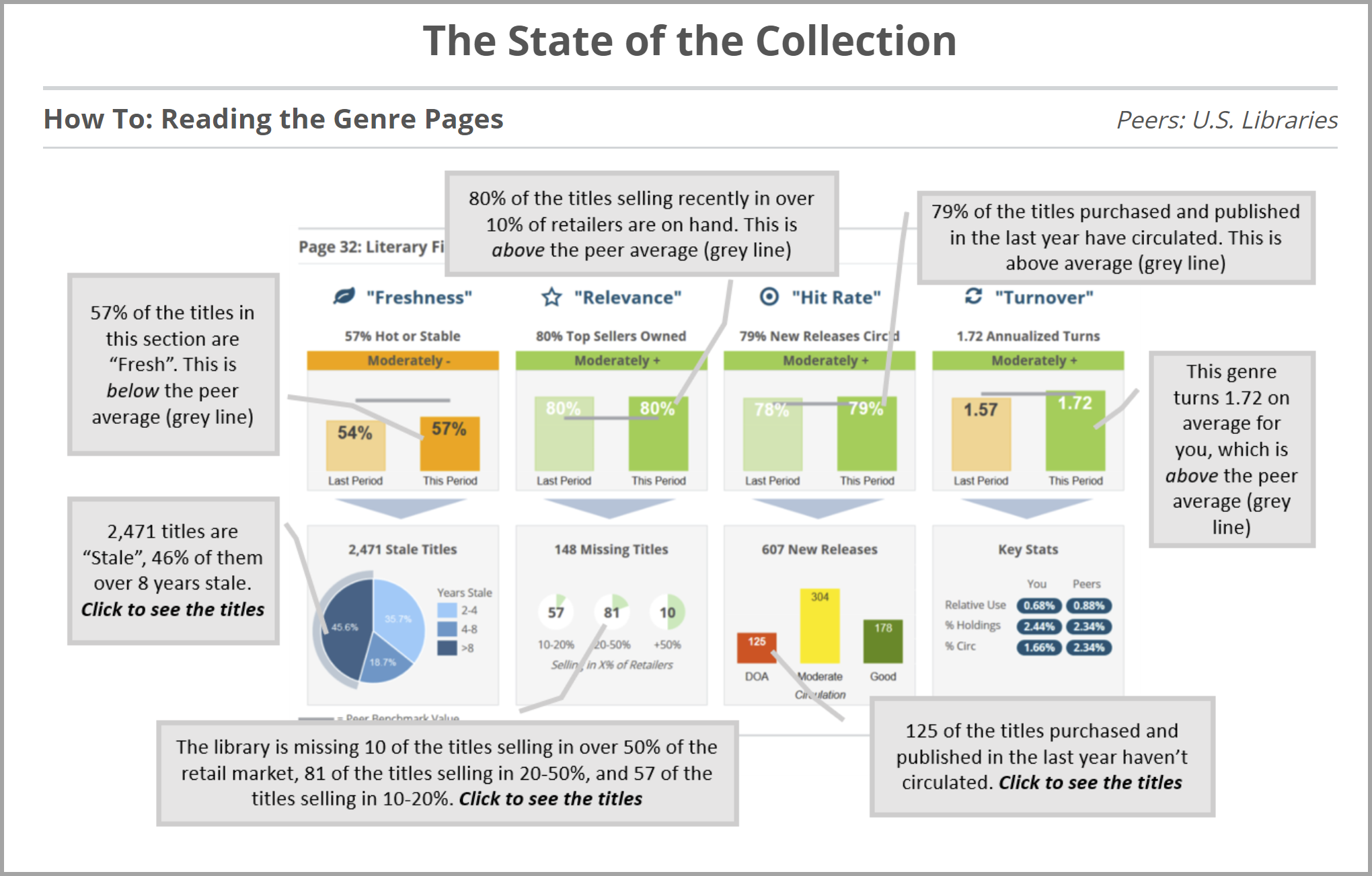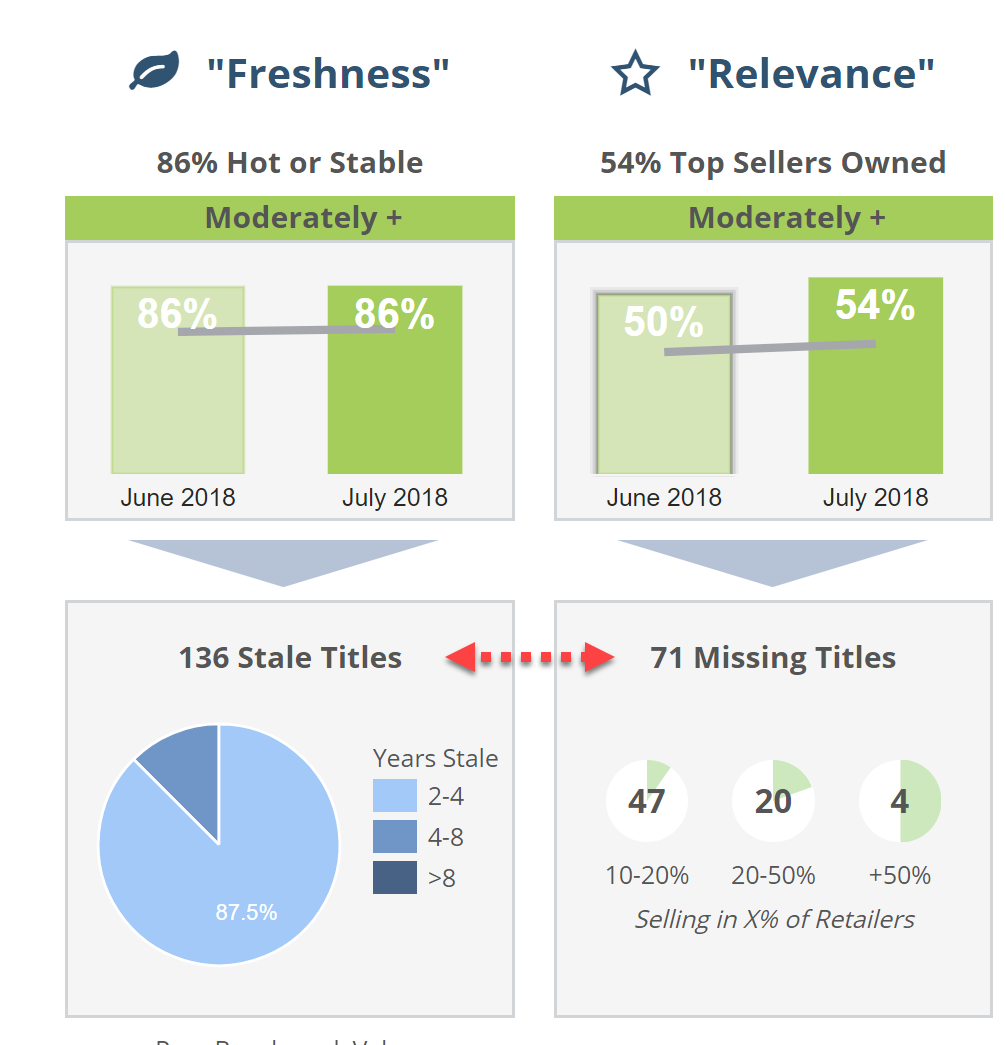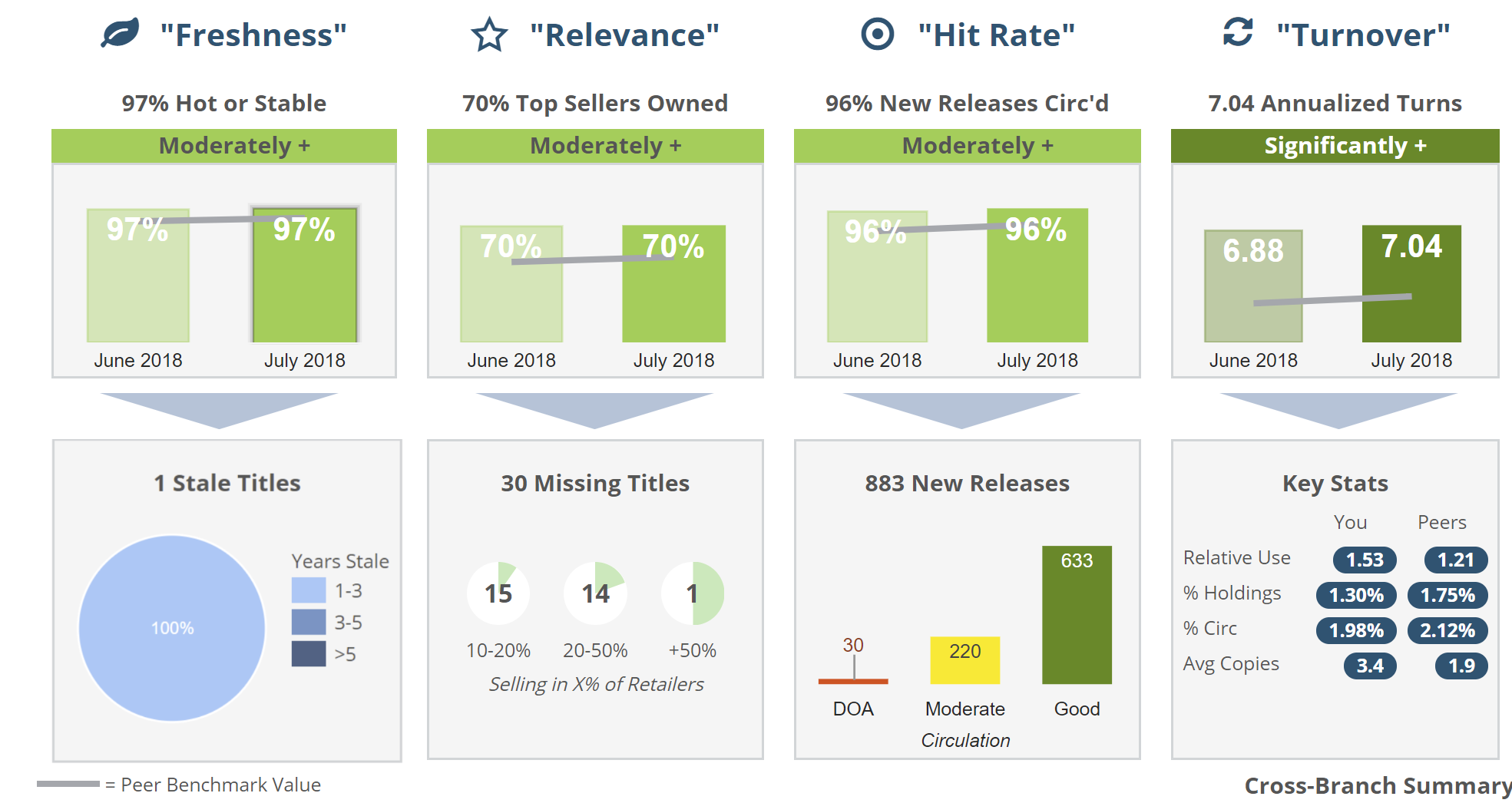Note that Page 3 of your State of the Collection Report indicates how to read the Genre Detail Pages:
Let’s dive in a bit deeper.
Freshness: Using the Edelweiss+ Analytics Shelf Days analysis, an overall measure of the % of your own collection that is circulating well, or not.
- A “Shelf Days” measure is calculated for every item owned
- Shelf Days = # of Copies Owned multiplied by the days since last activity (checked out, received, added to system)
- Example: 4 copies of a title last checked out 60 days ago would have a Shelf Days value = 240
- Anything with a Shelf Days value less than 730 (2 ‘copy years’) is “Fresh”, anything over that is “Stale”
- A genre’s overall “Freshness” is calculated as the number of “Fresh” titles as a % of total Titles
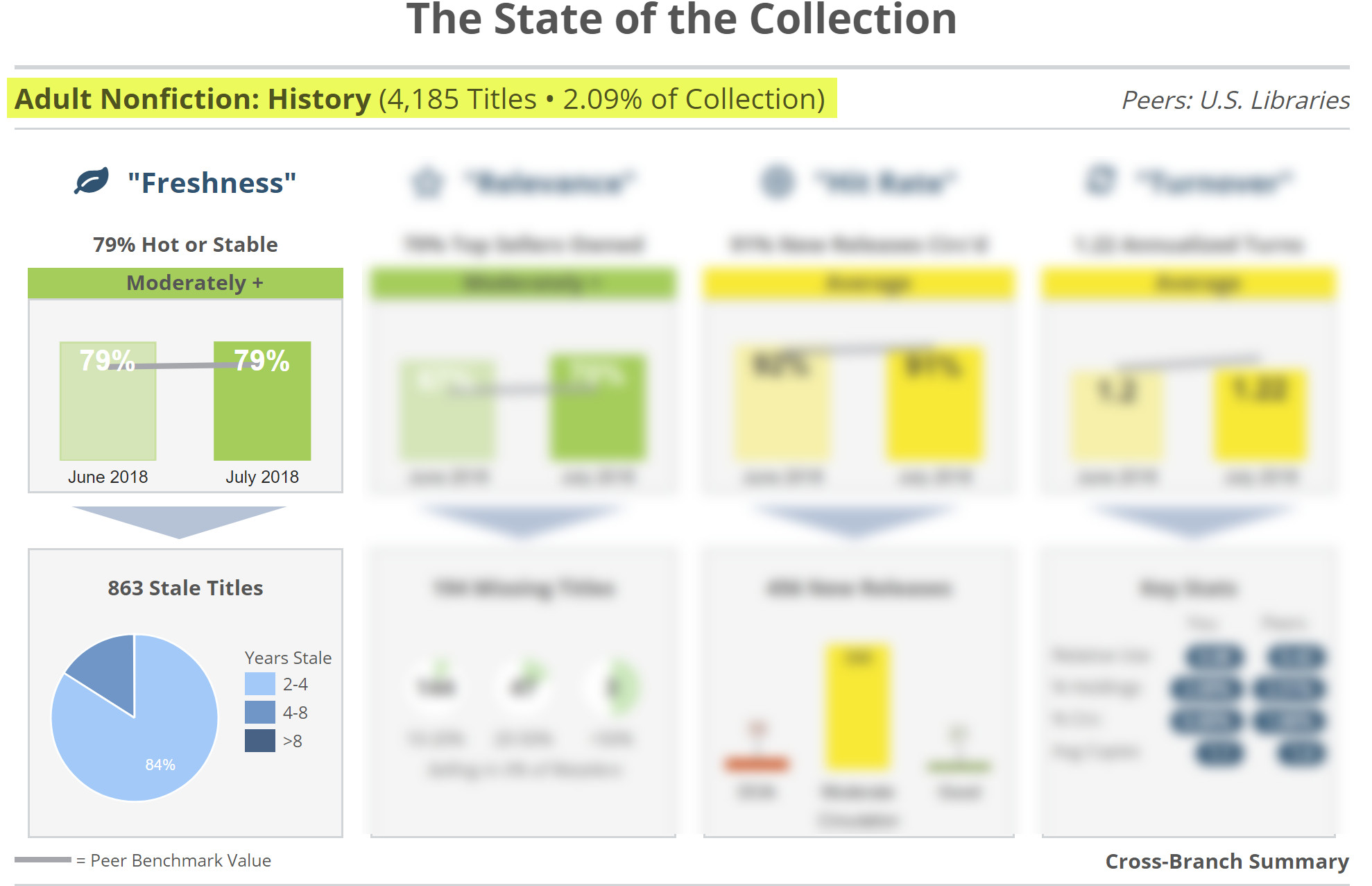 Highlighted at the top of this screen is the name of the genre, along with the total number of titles it contains, along with the % of the total collection it represents. Adult Nonfiction History is 2% of the total collection at this library. It has “above average Freshness,” which means that, for the most part, their History titles circulate pretty well. They do currently have 863 titles that haven’t circulated at all in over 2 years or more. Click on a piece of that blue pie to see which titles are stale (or click on the boxes to the right if the pie section is too small to click on).
Highlighted at the top of this screen is the name of the genre, along with the total number of titles it contains, along with the % of the total collection it represents. Adult Nonfiction History is 2% of the total collection at this library. It has “above average Freshness,” which means that, for the most part, their History titles circulate pretty well. They do currently have 863 titles that haven’t circulated at all in over 2 years or more. Click on a piece of that blue pie to see which titles are stale (or click on the boxes to the right if the pie section is too small to click on).
 The truth here is that while these may very well be great books, this library’s patrons are apparently not all that interested. It could also be that these titles haven’t circulated because they are no longer on the shelf due to theft. You could easily print this out as a “weeding list” by clicking Export to CSV in the upper right and then checking the shelves to see if the titles are there and evaluate them for possible weeding.
The truth here is that while these may very well be great books, this library’s patrons are apparently not all that interested. It could also be that these titles haven’t circulated because they are no longer on the shelf due to theft. You could easily print this out as a “weeding list” by clicking Export to CSV in the upper right and then checking the shelves to see if the titles are there and evaluate them for possible weeding.
Relevance:
Do you own titles that are selling well in the Indie market? Many times patrons will see a book at a bookstore or see it on a best seller list and come straight to the library to borrow it. That is were relevance comes in.
- We identify the titles selling in over 10% of the Indie bookstores across the country in the last 6 months (nearly 500 indies report to us on daily basis)
- The titles are grouped by “family” — to account for different editions / ISBNs of the same title
- Your holdings are analyzed against this list to determine what % of these titles / families you own by genre
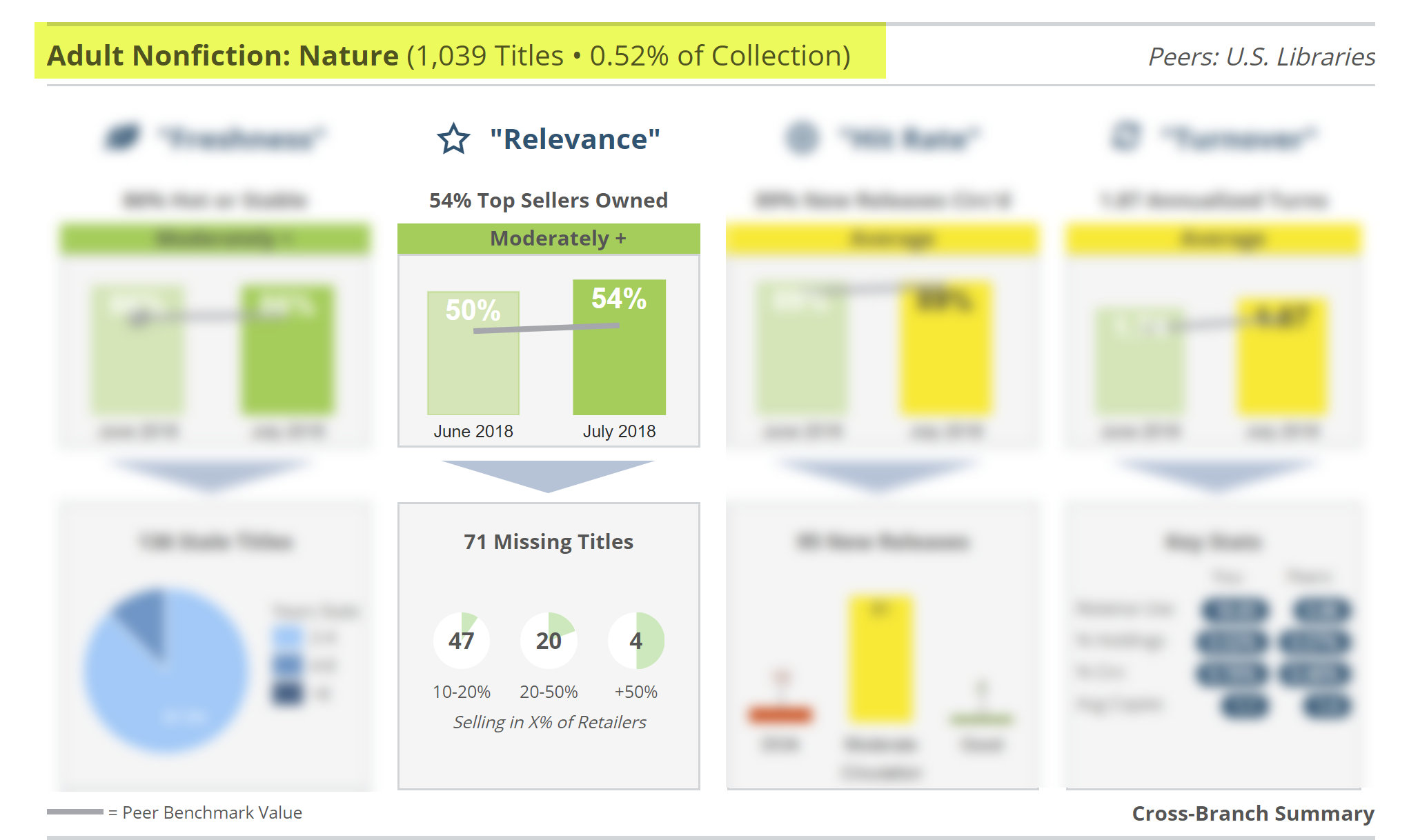 This library stocks 54% of the Adult Nonfiction: Nature titles that indie bookstores have sold in the last 6 months. They’re currently missing just 4 titles that the majority of stores are selling. Clicking on the green section of the pie will show the titles that they are missing.
This library stocks 54% of the Adult Nonfiction: Nature titles that indie bookstores have sold in the last 6 months. They’re currently missing just 4 titles that the majority of stores are selling. Clicking on the green section of the pie will show the titles that they are missing.
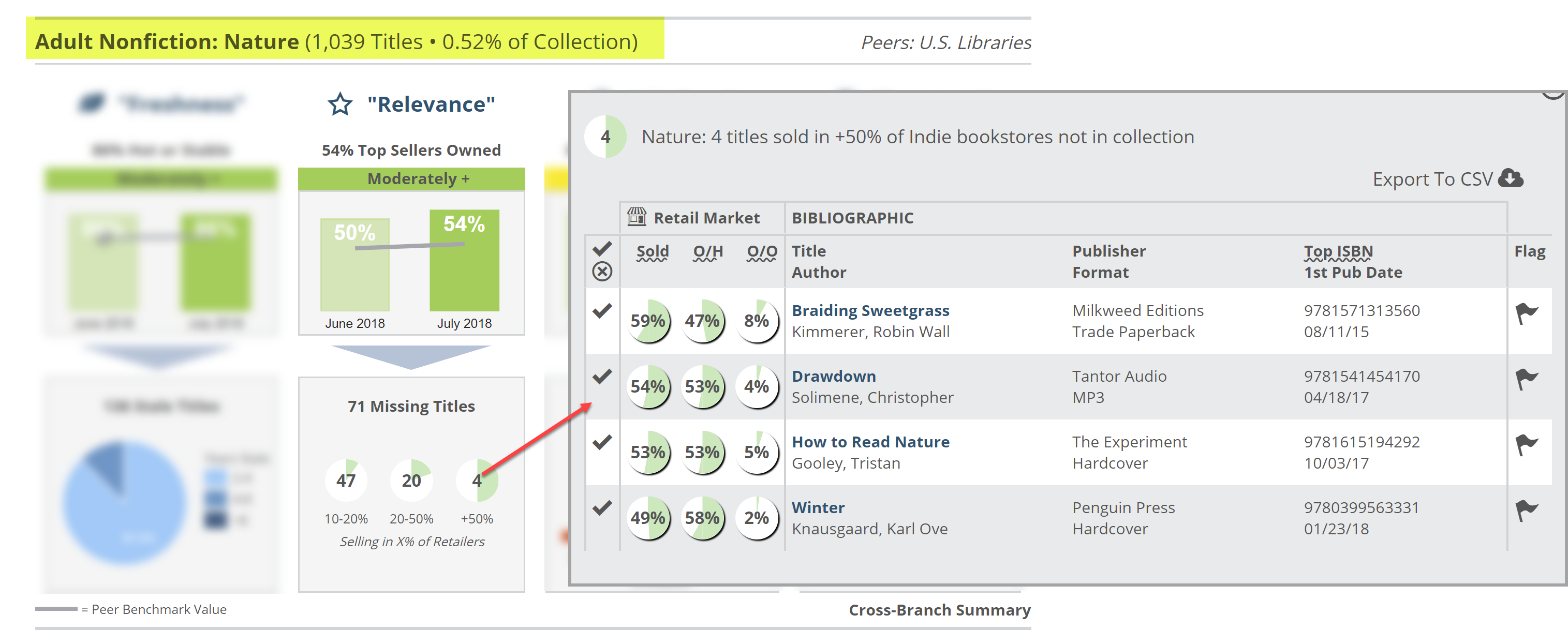 It’s worth noting that there are currently also 136 titles that show up in the Freshness graph as stale in the same genre. So you can swap out the titles that are not circulating for some suitable relevant titles.
It’s worth noting that there are currently also 136 titles that show up in the Freshness graph as stale in the same genre. So you can swap out the titles that are not circulating for some suitable relevant titles.
Note, too, that the gray bar in the top graph represents the average On Hand % value across the public library market (Peer Benchmark).
Each library has its own personality, and each community has its own distinctive tastes. You know your community and its personality the best but there is still a certain amount of guess work in collection development. Edelweiss provides the data to help in the selection process by providing the information on what is selling well in the market. That being said, sometimes what is selling in the market, isn’t being checked out by your patrons, which brings us to Hit Rate.
Hit Rate:
Measures the effectiveness of new purchases by showing whether or not newly published and purchased titles were ever checked out.
- The titles analyzed here are those that you own and that were published in the last 3 to 15 months
- “Hit Rate” is defined as the number of those titles that have been checked out at least once
- The titles that haven’t circulated are affectionately labeled “DOA” – dead on arrival
 Measuring the YA Fantasy/Sci-Fi genre at this library, we can see that a solid 84% of the new titles they purchased were checked out, which is right about the market average. The graph above indicates that 11 of those titles were checked out at least 10 times, and so land in the Good column, 195 were Moderate (1-10 checkouts), and 46 were DOA (dead on arrival…no checkouts). One could reasonably expect to see most of the newly purchased titles to have moderate circulation. It’s a relatively short list, and surely worth checking out, but the points of interest here are the outliers. The titles that circulated the most were clear wins, and knowing which titles those are will only serve to better inform you on the titles that do the best in this genre.
Measuring the YA Fantasy/Sci-Fi genre at this library, we can see that a solid 84% of the new titles they purchased were checked out, which is right about the market average. The graph above indicates that 11 of those titles were checked out at least 10 times, and so land in the Good column, 195 were Moderate (1-10 checkouts), and 46 were DOA (dead on arrival…no checkouts). One could reasonably expect to see most of the newly purchased titles to have moderate circulation. It’s a relatively short list, and surely worth checking out, but the points of interest here are the outliers. The titles that circulated the most were clear wins, and knowing which titles those are will only serve to better inform you on the titles that do the best in this genre.
Of course, going the other direction, you definitely want to know which titles were never checked out. If you can come up with a reason why, that would of course be ideal. Printing the list and taking a trip to the shelves might be painfully illuminating. Display issues are relatively easy to fix, but those intangible reasons that your patrons are simply not interested in a title (or 46 titles) are worth exploring. Obviously, allowing that information to inform future purchasing is probably a wise course of action. Click in each column to see a list of those titles. In that list, click on a title to see its page in Edelweiss.
Turns indicate how many times per year the average title circulated, a good overall measure for how hard your collection is working for you.
- Collection turnover is a very common measure used to look at the overall efficiency of a collection
- The calculation is as follows: Total 6 month circulation in units divided by the average collection size in units — and then multiplied by 2 to annualize the number
- Theoretically, collection turns represent the number of times per year the average title circulated
This measure essentially indicates not only how briskly your titles circulate, but whether or not your collection is overburdened with stale titles. As a general rule of thumb, a turn level of 3 indicates a relatively healthy collection. Inevitably, if you see a genre with low turns, you’ll also see a large amount of Stale titles in its Freshness measure.
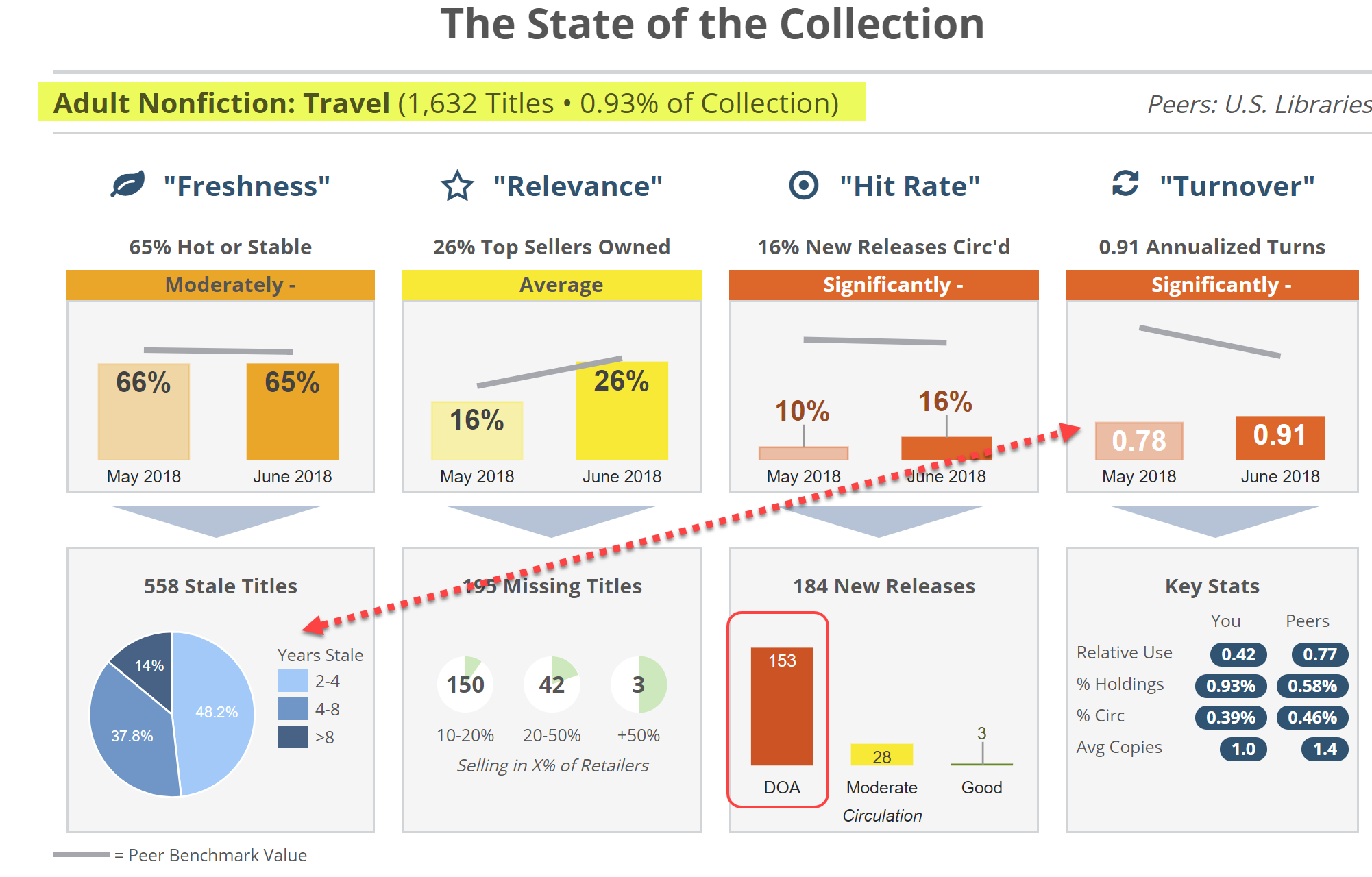 It’s relatively easy to see ways in which this category’s turns could improve… Weed the stale stuff, pay attention to that out-sized DOA column, etc. A library is constantly bringing in new titles, so it makes sense to constantly adjust the collection to make room for those new titles and adjust according to your patrons’ interest.
It’s relatively easy to see ways in which this category’s turns could improve… Weed the stale stuff, pay attention to that out-sized DOA column, etc. A library is constantly bringing in new titles, so it makes sense to constantly adjust the collection to make room for those new titles and adjust according to your patrons’ interest.
The Key Stats box shows a few points of interest:
- Relative Use: A ratio showing the difference between the % Holdings and % Circ numbers. A Relative Use number of “1” indicates balance. Less than 1 is overstocked, and over 1 is understocked, relatively speaking. The farther from 1, the more out of balance things are.
- % Holdings: The % of your total book collection represented by this genre.
- % Circ: The % of your total circulation represented by this genre. In the example above, this library’s Travel category circulation accounts for .39% of the total.
- Avg Copies: The average number of copies on hand for each title.
The Cross-Branch Summary provides a quick peek at how all your branches measure up with the specific genre you’re currently viewing:

